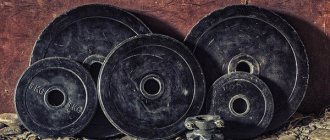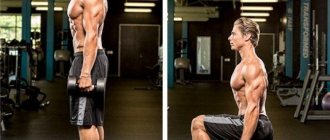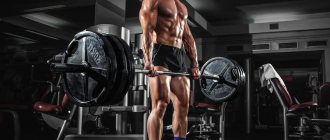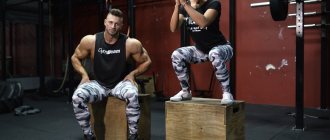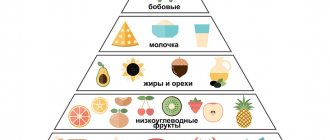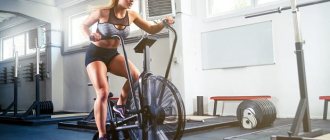Explaining all the principles of creating a proper training program may require the creation of a separate book, which is what professional trainers most often do. But there are general and basic points - the necessary minimum from which you can build on in the process of developing a personal program.
It must be said right away that the material is relatively voluminous, but if you study it in full, then half of your questions regarding the construction of a training plan will immediately disappear. And this is easier both for the trainer and for the novice bodybuilder, because you will understand the scheme for drawing up programs and all that remains is to try everything in practice, using your own feelings.
There is often a situation where beginners move chaotically between exercise machines and change the program every workout. This prevents their body from understanding what is happening, and it is impossible to notice the advantages and disadvantages of the chosen program in one workout. The result will be obtained if you follow the chosen program for a certain time (several weeks or months).
Also, many novice bodybuilders believe that there is a certain scheme with secret techniques that will give instant results, and if you also use steroids, then everything becomes simple! These are all misconceptions, because to achieve the goal you need to work in the gym for a very long time.
Preparation of a workout for a beginner by a trainer
Maybe someone else doesn’t know, but for each newcomer, coaches create approximately the same plans with minor adjustments. Usually these are basic exercises and a couple of isolating exercises (which exercises are basic and which are isolating, read here). At first glance, this seems like the wrong approach, because the program should be individual, but you need to understand one important point.
Coaches cannot create an ideal action strategy right away! Therefore, we get a situation with a standard program, which will be the same as for all other beginners. The coach must independently determine the degree of preparation of the athlete and adjust his goals, and after a short interval the coach creates an individual training session, taking into account all the characteristics of the athlete’s body. As a result, after these words, any stable strategy is initially better than its complete absence.
How long to rest between sets
To develop a competent individual training program, it is important to understand how and how much you can rest between approaches.
- When gaining weight, when an athlete gives his best and works to failure, the muscles become very tired, so they need to rest for two minutes between approaches.
- When working to increase strength, rest can be 4-5 minutes when the athlete lifts maximum weights for 4-6 repetitions.
- When developing endurance, improving relief and losing weight, it is enough to rest for an average of 30-60 seconds.
- In circuit training, exercises are performed one after another without rest. A break is taken at the end of the circle and lasts 1-2 minutes.
How often should you go to training?
From the very beginning, any athlete asks this question, but to choose the optimal number of training sessions per week, several factors need to be taken into account:
1. Which muscle groups will be involved.
All muscle groups can be divided into two categories:
- small (calves, deltoids, triceps, biceps);
- large (chest, back, legs).
Remember that if the training was on large muscles, then they will need a day more break for recovery than a group of small muscles.
2. Current level of preparation. If you have been training for a long time, then the body is adapted to the stress and the muscles are restored in a shorter period of time. Also, smaller muscles recover faster.
3. Training volume. It is definitely worth taking into account. If the training was long and hard, then the body received a colossal load. This means it will take a long time to fully recover. Don't forget about supercompensation and learn to determine when your body is ready for stress again.
Of course, each coach has his own view on the required intervals between workouts. But most are inclined to believe that a beginner can visit the gym often at first, but with light loads. This solution allows you to gradually adapt to the loads and increase the efficiency of training. Another aspect of this solution is that a beginner’s muscles are not yet very voluminous, which means they recover faster than the voluminous fibers of a professional.
When creating a program, keep in mind that on average, for beginner athletes, each muscle group is completely restored in 2-4 days.
In one of the articles on our website, we talked in more detail about how often you should go to the gym. Statistics, differences for beginners and experienced athletes, as well as features of post-gym training during strength and fat-burning training.
How many times to train a week?
After choosing a goal, the stage of forming the structure of the training program begins. The number of training days should be determined based on your level of training. A beginner athlete will need more time to recover than an amateur or professional. At this level, it is worth starting with 2-3 days a week, gradually increasing the number of classes over time. It is also important to control the amount of work: if the workout is excessively long and intense, the body will need a longer rest. The optimal training time in the first stages is 45-60 minutes.
How to properly combine muscle groups in one workout
If you are doing a split workout, it is not recommended to load several large muscle groups at once with one workout! The best option would be to involve one large and a number of small groups.
A bad example would be training your back and legs at once. Firstly, this is a high load, which will not allow you to give your best in each exercise - you simply do not have enough strength for it! And secondly, the load on the circulatory system (on the heart in particular) will be enormous. The muscles are large, require a supply of nutrients, and are located at a considerable distance.
The exception is training for antagonist muscles - this is the name given to a pair of muscles that perform opposite movements. For example, the biceps flexes the arm, and the triceps extends it, the pecs push the arms, and the latissimus dorsi pull. Therefore, training them together is an excellent option, especially since they will be involved in any case. As an example, biceps curls passively engage the triceps, which is stretched and ready to be loaded. Exercises on antagonist muscles in one workout enhance the pumping effect.
Separately, you need to touch the feet, because this group stands out among all the others. In the human body, the legs are the largest and strongest muscle group, so when using splits, it is better to dedicate a separate day to them. Let's consider the optimal split options:
3 days a week (best option)
- chest and back;
- deltas and arms;
- legs.
5-day (advanced)
- legs;
- back;
- breast;
- shoulders;
- hands.
After using these splits, you still need to figure out optimal rest. Everything here is relatively simple; if there are no results, it means either training is frequent, or vice versa – the breaks are too long. Therefore, if you feel that you need an additional day of rest, it is better to do it than to once again load muscles that have not yet rested.
In order to achieve the maximum effect from training, it is necessary to correctly determine when your body received supercompensation after training. How often do you need to train and what is supercompensation? Read this article.
Mass gain program
The basic program is considered to be the most effective for gaining muscle mass - especially for naturally thin guys. Its logic is based on the fact that muscle growth works best with five multi-joint basic exercises, performed in 4-6 sets of 4-6 repetitions (this, in turn, requires large working weights) and increasing the load in each workout.
When drawing up an individual training plan for muscle growth, it is recommended to take the basic program as a basis, modifying it to suit your own needs, your work or study schedule, as well as the equipment available. However, it is important to remember that the purpose of your training and your age will always impose restrictions on the specifics of the training.
Training muscle groups by day
In most cases, the preparation of a program with a breakdown of muscle groups by day is based on a combination of strength training with other physical activities that a person practices. For example, if you go swimming on Tuesday, then it is best to train your back and arms on Friday rather than on Monday.
In any case, as we already mentioned above in the rules for creating a program, first the main muscle group of the day is selected (legs, back, chest), then secondary ones are added to the exercises for this muscle group (most often shoulders are combined with legs, biceps with back, and triceps with chest) - however, this is a general recommendation, and an individual training plan may be drawn up differently.
What is the sequence of exercises
You need to choose a split taking into account your goal. If the main goal is to gain mass, then you need to forget about isolation exercises. Only the base is used - exercises that involve several muscle groups at once. Therefore, when gaining weight, you need to pass by all the exercise machines; they are not designed for this purpose.
If you are a skinny guy who has just started going to the gym, then you have a direct path to dumbbells and barbells (free weights), this is where you should spend most of your training time.
When gaining mass, the sequence also looks simple, which involves first complex exercises during the workout, and easy ones at the end. You need to start with an exercise that involves the maximum number of joints (base), and end with isolating exercises.
As an example, when training the pectoral muscles, you need to start with a bench press and end with a crossover or dumbbell flyes, which are formative exercises. When training your legs, it is important to start with squats, and only then move on to extensions on the machine.
Important! When training to gain mass, be sure to follow the rule: from difficult to easy: from basic exercises to isolating ones.
Defining the Goal
First of all, it is necessary to formulate the purpose of training and highlight the main areas of work. The reasons for visiting the gym can be different:
- gaining muscle mass;
- weight loss or weight loss;
- development of physical qualities (strength, agility, flexibility, coordination, endurance);
- rehabilitation after injuries;
- work on muscle relief;
- maintaining current physical fitness.
It is worth mentioning that the effectiveness of the training program is closely related to the nutrition plan, so in addition to working out in the gym, you need to train yourself to track the calories you eat and the ratio of proteins, fats, and carbohydrates.
The nutrition program should also correspond to your main goal. You can read about nutritional features during mass gain in one of our previous articles.
Designing a workout
When starting to create a training program, it is important to consider the following criteria:
- load (as a percentage of your maximum) - it is important to determine the weight that will allow you to perform the exercises correctly.
— the number of sets/approaches in each exercise — to gain mass, you need to do 6-10 repetitions per approach, and for strength you will need no more than 5.
- tempo of exercises (speed) - approaches can be performed quickly, but more often they concentrate on a specific phase (lifting/lowering)
- duration of training - if you are not using steroids, then the training should last a maximum of 1 hour. And all because such loads are stress for the body, which causes the release of catabolics into the blood. If this stress extends over time, then the body will take a long time to recover, which is due to a decrease in the volume of anabolic steroids produced by the body (for example, testosterone).
- rest until the next approach - no need to relax in the gym, stretching out the rest. You can rest for a maximum of 2 minutes, but generally only 1 minute is recommended. This will allow you to do 5-6 exercises with average weight in the allotted hour. You can only rest for more than 3 minutes when powerlifting (building strength).
What should be the number of repetitions
I will make a separate article on this topic. Now I will only say the main points. If your goal is to gain muscle mass, you should almost always do 6-12 reps per set. But it must be said that the number of repetitions is not so important!
The most important thing is to take into account the time the muscle is under load! The load should lead to muscle failure within 10-30 seconds.
Those. if it is, for example, a large muscle such as the quadriceps, then muscle failure will occur in the desired interval of 10-30 seconds just when performing 6-12 repetitions, but if it is a muscle that makes movements in a small amplitude, such as the calf, then you should do 15-20 repetitions. I think this is clear.
The smaller the range of motion of the muscle being trained, the more repetitions should be done to achieve muscle failure in the range of 10-30 seconds.
The importance of warming up with a cool down
If at least some attention is paid to the warm-up more often, then many people forget about the cool-down, simply leaving for the shower or leaving the gym at the end of the entire workout. But both of these actions are important to get the maximum effect.
Spend a few minutes on the cardio machine to warm up your body, and do some general warm-up and stretching. Before each basic (complex) exercise, do a set with a light weight.
After training, it is important to do a cool-down to bring the body into a normal state, as well as to start the recovery process. A cool-down requires up to 10 minutes of time and consists of any aerobic exercise that turns into muscle stretching (treadmill, and then stretching). This will return the body to normal and even out the pulse.
If you do not want to get injured during training, be sure to do a warm-up. On our website there is a large article about warming up, stretching and cool down. From it you will learn the order of its implementation, as well as a video with the warm-up process.
What weights to take
Choosing the right weight to work with is just as important as creating the right training program. The success of your training will depend on your weight. Therefore, the best and most effective exercises will not produce results if the weight is either too heavy or not enough. If heavy weight is more likely to lead to injury, then light weight does not fully load the muscles, which reduces the productivity of exercise.
There is a method called one rep maximum, in which one repetition is performed with a maximum weight of 100%. From this, depending on the goals, the weight is selected. For example, for weight gain, 70-80% of 1 RM is used, and for weight loss, as well as for beginners - 40-50%. But in fact, this method is not suitable for beginners, since an untrained person will not be able to perform this approach to determine the maximum weight. Therefore, everything will happen by selection method.
How to do it: take a light weight and perform the number of repetitions you need. If it was too easy, add weight. And so on until the last two repetitions are performed until the muscles are completely tired. Then it is important to record your working weight, and in the next workouts build on this indicator.
Bodybuilding and the eternal question of nutrition
A novice bodybuilder comes to the gym with the confidence that results can only be achieved with the help of pharmacology and the constant use of sports nutrition. But this is far from reality, because any supplements only complement the normal diet, as the name suggests. It is important to understand that sports nutrition is an additive to regular food, but not a chemical. Sports nutrition differs only in ease of preparation and use, and the supplements themselves are divided into several types:
- amino acids;
- protein;
- gainer;
- minerals and vitamins;
- creatine;
- fat burners.
All of these types of sports nutrition perform different functions. There is no need to immediately convince yourself that nothing will work without additives, it is important to read the necessary articles and you can get good results without resorting to buying sports nutrition. But with sports nutrition it will still be easier.)
Sports nutrition is a great help in building your body. By using sports nutrition, your goals will be achieved easier and faster. Go to our store - it presents only the most popular sports nutrition.
Training program for girls using plyometrics
This type of training is suitable for girls who are already familiar with intensive training and who have no contraindications to this type of training (see above).
Type of training: classic training in sets (x4 - 4 sets or x1 - 1 set). Rest between sets – 7 seconds.
Working muscle groups: chest, arms and legs.
Working time: 30 seconds (this is one approach).
Rest: 7 sec.
Equipment: dumbbells 1-3 kg, jump rope.
Warm-up and joint gymnastics - 5-7 min
- Stepping up a hill – 30 seconds with each leg in turn (x4)
- Burpees with push-ups – 30 sec x1
- Scissor plank – 30 sec x1
- Raising arms to the sides while lying on your back – 30 sec x4
- Squat jump – 30 sec x1
- Jumping rope – 30 sec x1
- Squat and leg lift to the side - 30 seconds with each leg in turn (x4)
- Wide grip push-ups upside down – 30 sec x4
- Squat jump with a 180 degree turn – 30 sec x1
- Jumping lunges – 30 sec x1
Stretching
Additional nuances of effective training
If you are determined to go to the gym, and the decision to gain weight or get strong muscles is serious, then it is important to follow the following rules:
- Strict adherence to the daily routine along with diet. If the training is organized efficiently, but the nutrition remains the same and incomplete, there will be no result. And all because a large part of success depends on proper nutrition, especially in an activity like bodybuilding. Therefore, it is important to immediately adjust your diet and regimen, selecting the best options for a certain type of training. Only this will create conditions for active muscle growth. It is recommended to sleep at least 7 hours a day and avoid stress.
- Periodic change of program. Training plans are designed for a specific time (usually 2-6 months). This is due to the body’s adaptation to stress, which reduces the effectiveness of training to zero. To continue to develop, you need to change both individual exercises and the entire program. One option is to switch from bodybuilding to powerlifting, and then back again.
- Dynamics tracking. It is important to always track the results during the process by recording them in a diary. Only the fact of progress, which can be expressed in an increase in weights or external changes, indicates the correctness of the chosen strategy. If the program does not advance towards the goal, then it is wrong and you need to think about a new plan.
Training program for girls using the pumping principle
This workout is most suitable for girls who have a pear or hourglass figure type, as it is mainly aimed at working out problem areas such as thighs, buttocks and triceps.
Type of training: circular. In total you need to do 3 circles of 7 exercises. There is no rest between exercises, rest between circles is 2 minutes.
Working muscle groups: legs, buttocks and triceps.
Number of repetitions: from 15 to 40.
Equipment: dumbbells 1-3 kg, jump rope.
Warm-up and joint exercises - 5-7 minutes.
- Squats – 15 and 10, 3 springs at the lowest point.
- Extension of arms from behind the head while sitting – 15 and 10, 3 springs at the bottom
- Back lunges – 15 and 15, 3 springs each (first we lunge with our right foot, then with our left)
- Reverse push-ups from the bench – 12-15
- Pulling the leg back in a knee-elbow position – 20 and 15, 3 springs at the top point (each leg)
- Close grip push-ups from knees – 12
- Leg swings lying on your side – 20 and 20 with 3 springs at the top (first with the right leg, then with the left)
Rest – 2 minutes.
Repeat the entire complex 2 more times.
Cardio: jumping rope - 15 minutes.
Stretching.
- Weight loss training program for girls with an hourglass figure type
Static and dynamic exercises
All exercises can be divided according to the type of muscle contraction. Static and dynamic loads work different types of muscle fibers, so the most effective workout combines them. Dynamic exercises primarily involve classical strength training and cardio training, so let’s take a closer look at the static ones.
Static exercises
Examples: straight and side planks, planks on a fitball or in gymnastic loops, yoga asanas.
Statics is holding the body in a certain position for some time. It involves working muscles for endurance without increasing their volume and growth, that is, static exercises are not suitable for improving muscle tone and gaining sculpted shapes.
Advantages
- Developing endurance and flexibility by increasing muscle fiber strength.
- Positive effect on the body: strengthening the immune system, improving blood circulation, actively saturating the blood with oxygen.
Indications and contraindications
Ideal for those who want to be strong without radically changing their figure. Static loads are not recommended for people over 40 years old, as well as for beginners in sports.
Optimal combination
When drawing up a training plan for women, the optimal combination of loads is ⅓ static and ⅔ dynamic. For men, it is better to slightly increase the number of static exercises - up to 40%. Beginning athletes should gradually include static loads in their training (after 1–2 months of performing dynamic exercises).
Create a combination of exercises
Selecting the appropriate exercises and combining them for a good training plan requires some experience. Therefore, it is better for beginners to contact a coach or an experienced athlete to help them prepare for training.
When choosing the right exercises, it is important to consider three factors - load, interaction with other exercises and complexity of the technique . Therefore, we do not recommend that you combine [6]:
- heavy weights or intense exercises that target the same muscle groups
- two exercises that apply pressure to one joint
- exercises that cause muscle spasms
- two exercises in a row that can quickly raise your blood pressure
On the other hand , it is suitable for your training plan to include a combination of [6]:
- different muscle groups
- similar muscle groups if you want to achieve muscle volume
- technically intensive exercises combined with less technically demanding exercises
To help you understand this better, we will explain it . A good example is the combination of front squats (4 sets of 5 reps) followed by pull-ups (4 sets of 12 reps). The exercises primarily work the arms and back, while the legs, lower back, and midsection are all involved in front squats. This way, different muscles have the opportunity to relax and do not immediately tense up.
A bad example is a combination of front squats (4 sets of 5 reps) and then deadlifts (4 sets of 12 reps). During a deadlift, you use your arms and upper back just like you would with a pull-up bar, and that's okay. But to a large extent, you are straining your lower back , which you also strained during squats. Therefore, this combination may cause pain in the sacrum before the start of the third set.
Medical contraindications for exercising in a fitness club:
- acute infectious diseases;
- all diseases in the active phase;
- chronic diseases during exacerbation;
- organic diseases of the central nervous system;
- malignant neoplasms;
- diseases of the musculoskeletal system with a progressive course and a sharp dysfunction of the joints and the presence of pain;
- some of the diseases of the respiratory system, cardiovascular system, and digestive system.
Create your training plan based on these points.
You're almost ready to workout, you just need to make a schedule. Here are some examples of what your workouts could look like. Choose yours depending on your fitness goal. [6]
Strength training
| Training category | Exercise | Number of approaches and repetitions |
| Upper body - pressure | Bench Press | 4 x 5 |
| Upper body - movement | Middle block thrust | 3 x 12 (each arm) |
| Hip flexion | Deadlift | 4 x 5 |
| Calf muscles | Long jump | 4 x 12 |
| Quadriceps major muscle | Front Squats | 3 x 8 |
| Mid body | Leg raises on the bar | 3 x 12 |
| Special exercises | ||
| Small thigh muscles | Side Lying Knee Raises Clamshells | 2 – 3 x 15 |
| Grip | Farmer walks | 2 – 3 x 90 sec. |
Mass gain workout
| Training category | Exercise | Number of approaches and repetitions |
| Upper body - movement | Bends on the crossbar | 3 x 12 |
| Upper body - pressure | Bench Press | 3 x 12 |
| Quadriceps major muscle | Front Squats | 4 x 6 – 8 |
| Upper body - pressure | Seated Shoulder Press – Overhead Press | 3 x 12 |
| Hip flexion | Bridge – Hip thrust | 3 x 12 |
| Upper body - movement | Leg raises on the bar | 3 x 12 |
| Shoulders | Dumbbell Pull to Chest – Chest supported row | 3 x 12 |
| Special exercises | ||
| Mid body | Leg Raises – Reverse Crunch | 2 – 3 x 15 |
| Grip | Wrist Strengthening Exercises – Wrist Curls | 2 – 3 x 90 sec. |
Weight loss workout
| Training category | Exercise | Number of approaches and repetitions |
| Cardio | Sprint | 15 minutes. |
| Upper body - pressure | Push ups | 3 x 12 |
| Condition | Pushing a block – Sled push | 3 x 60 seconds |
| Hip flexion | Bridge – Hip thrust | 3 x 12 |
| Condition | Exercise with ropes – Battling Ropes | 3 x 30 seconds |
| Quadriceps major muscle | Weighted Squats – Goblet Squat | 3 x 12 |
| Upper body - movement | Bends on the crossbar | 3 x 12 |
| Special exercises | ||
| Shoulders | Dumbbell Raise – Prone L Raise | 3 x 15 |
| Mobility and balance | Stretching with a roller for training | 3 minutes |
Don't forget about the core muscles
Make it a habit to pump up your abs at the beginning of your workout. Not everyone has time for a quality warm-up, and some even skip it altogether. Because of this, training productivity decreases. When you do abs in the beginning, you are 100% warming up your body and preparing it for the main exercises.
The core muscles are usually ignored, since their work is postponed to the end of the lesson.
Photo: istockphoto.com
We train lagging muscles first
In fitness and bodybuilding, there is a principle of priority - first of all, attention is paid to weaker muscles. If you have managed to gain several kilograms of muscle mass and can determine which group you need to work on, this method is for you.
Use it until the muscles reach the required level, and then return to training large groups.
The principle of priority is a temporary measure to achieve the desired aesthetics.
Photo: istockphoto.com
